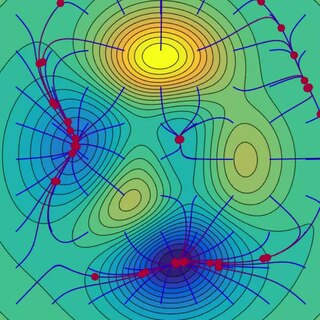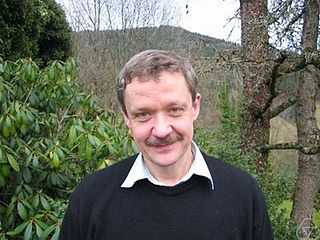
Mathematical optimization or mathematical programming is the selection of a best element, with regard to some criterion, from some set of available alternatives. It is generally divided into two subfields: discrete optimization and continuous optimization. Optimization problems arise in all quantitative disciplines from computer science and engineering to operations research and economics, and the development of solution methods has been of interest in mathematics for centuries.

Gradient descent is a method for unconstrained mathematical optimization. It is a first-order iterative algorithm for finding a local minimum of a differentiable multivariate function.
In mathematics, engineering, computer science and economics, an optimization problem is the problem of finding the best solution from all feasible solutions.

In the design of experiments, optimal experimental designs are a class of experimental designs that are optimal with respect to some statistical criterion. The creation of this field of statistics has been credited to Danish statistician Kirstine Smith.
Convex optimization is a subfield of mathematical optimization that studies the problem of minimizing convex functions over convex sets. Many classes of convex optimization problems admit polynomial-time algorithms, whereas mathematical optimization is in general NP-hard.
Semidefinite programming (SDP) is a subfield of mathematical programming concerned with the optimization of a linear objective function over the intersection of the cone of positive semidefinite matrices with an affine space, i.e., a spectrahedron.
In convex optimization, a linear matrix inequality (LMI) is an expression of the form
In an optimization problem, a slack variable is a variable that is added to an inequality constraint to transform it into an equality. Introducing a slack variable replaces an inequality constraint with an equality constraint and a non-negativity constraint on the slack variable.
A second-order cone program (SOCP) is a convex optimization problem of the form
A geometric program (GP) is an optimization problem of the form
Conic optimization is a subfield of convex optimization that studies problems consisting of minimizing a convex function over the intersection of an affine subspace and a convex cone.
Arkadi Nemirovski is a professor at the H. Milton Stewart School of Industrial and Systems Engineering at the Georgia Institute of Technology. He has been a leader in continuous optimization and is best known for his work on the ellipsoid method, modern interior-point methods and robust optimization.
Strong duality is a condition in mathematical optimization in which the primal optimal objective and the dual optimal objective are equal. By definition, strong duality holds if and only if the duality gap is equal to 0. This is opposed to weak duality.

Proximal gradient methods are a generalized form of projection used to solve non-differentiable convex optimization problems.
Jan Camiel Willems was a Belgian mathematical system theorist who has done most of his scientific work while residing in the Netherlands and the United States. He is most noted for the introduction of the notion of a dissipative system and for the development of the behavioral approach to systems theory.

Yurii Nesterov is a Russian mathematician, an internationally recognized expert in convex optimization, especially in the development of efficient algorithms and numerical optimization analysis. He is currently a professor at the University of Louvain (UCLouvain).
Finsler's lemma is a mathematical result named after Paul Finsler. It states equivalent ways to express the positive definiteness of a quadratic form Q constrained by a linear form L. Since it is equivalent to another lemmas used in optimization and control theory, such as Yakubovich's S-lemma, Finsler's lemma has been given many proofs and has been widely used, particularly in results related to robust optimization and linear matrix inequalities.
The S-procedure or S-lemma is a mathematical result that gives conditions under which a particular quadratic inequality is a consequence of another quadratic inequality. The S-procedure was developed independently in a number of different contexts and has applications in control theory, linear algebra and mathematical optimization.
Design optimization is an engineering design methodology using a mathematical formulation of a design problem to support selection of the optimal design among many alternatives. Design optimization involves the following stages:
- Variables: Describe the design alternatives
- Objective: Elected functional combination of variables
- Constraints: Combination of Variables expressed as equalities or inequalities that must be satisfied for any acceptable design alternative
- Feasibility: Values for set of variables that satisfies all constraints and minimizes/maximizes Objective.
Eric Marie Feron is a computer scientist and aerospace engineer. He has been the Dutton/Ducoffe Professor of Aerospace Software Engineering at Georgia Tech since 2005.





